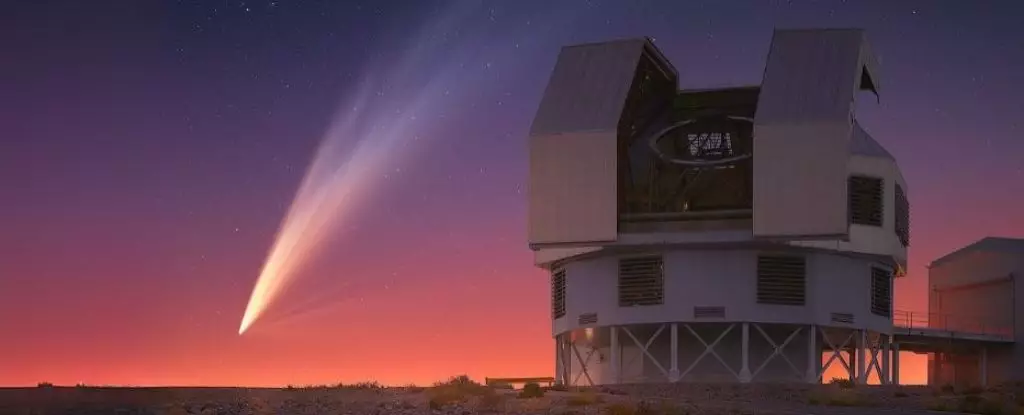Comet watching has long been a captivating endeavor for astronomers and enthusiasts alike. These dynamic celestial objects offer not only aesthetic beauty but also significant insights into our solar system’s history. Among recent discoveries, Comet C/2024 G3 ATLAS, unearthed on April 25, 2024, by the Asteroid Terrestrial-impact Last Alert System (ATLAS), has garnered attention thanks to its predicted brightness and subsequent performance. However, the unpredictable nature of comets serves as a reminder of the tenuous balance between scientific expectation and natural reality.
Comet G3 ATLAS appeared promising shortly after its discovery. Anticipation ran high as it approached perihelion—the point in its orbit where it comes closest to the Sun. This event was expected to unfold in January 2025, leading to predictions of a potentially dazzling display for avid skywatchers. Historical references cement this excitement, as certain comets over the years have dramatically exceeded expectations, while others have notably underperformed. Notable past examples include Comet ISON, which met an unfortunate demise in 2013, contrasting sharply with Comet Lovejoy, which gracefully survived a perilously close approach to the Sun.
The unforeseen trajectory of G3 ATLAS began to unfold as it neared perihelion on January 13, 2025, passing within a mere 14 million kilometers of the Sun. This close encounter was marked by a spike in brightness—at one point, the comet reached an impressive magnitude of -3.8, making it the most brilliant comet observed since P1 McNaught in 2007. The excitement surrounding its visibility raised hopes for those located in the northern hemisphere, who have often felt overlooked by brighter comets that tend to favor southern skies.
Despite its spectacular initial brightness, G3 ATLAS almost immediately fell victim to a familiar pattern in the behavior of bright comets: a preference for southern hemisphere visibility. While a portion of the comet’s passage graced the northern skies between January 8 and January 15, most observers were left with little more than anticipation and disappointment as the comet retreated southward. Ironically, this characteristic has often left northern observers grappling with a sense of exclusion when attempting to witness these celestial wonders.
Nevertheless, the adeptness of skilled astrophotographers allowed for the capture of fleeting glimpses of G3 ATLAS as it began to unfurl its tail, showcasing the intricate beauty of its dust and ion components. The striking phenomenon evident in these images, known as syndynes, adds to the mystique of cometary tails, which, fueled by the solar wind, trail behind the nucleus but extend outward during the comet’s journey.
Unfortunately, as the comet reached perihelion, visible signs of deterioration quickly surfaced. By January 18, images revealed that G3 ATLAS was undergoing a notable decline, as the nucleus appeared to fade significantly. The comet transitioned into what is often termed a “headless” comet; while the tail maintained semblance of brilliance, the nucleus’s fading presence signaled its fragility.
While G3 ATLAS had once exhibited enormous potential, this downward trajectory serves as a reminder of the transient nature of comets. It currently shines at +5 magnitude, struggling to maintain visibility in the constellation Piscis Austrinus. Its original orbital path measured approximately 160,000 years in duration inbound, and its exit trajectory estimates span a remarkable 600,000 years. This period heralds the possibility of fragments re-entering the inner solar system eons from now, linking past celestial events with future possibilities.
What does the journey of Comet G3 ATLAS teach us about expectations and reality in astronomy? It serves as a testament to the beauty and unpredictability of these icy wanderers. As the comet fades into the cosmic ether, the experience relayed by observers enhances our understanding of the natural processes at work, while the stories of those who dare to document their fleeting beauty, like astrophotographer Dylan O’Donnell, enrich the camaraderie found in the pursuit of knowledge among enthusiasts.
While Comet G3 ATLAS may not have performed as originally hoped, its existence, and the journey it took, remind us of the ever-present allure of the cosmos—a playground of unpredictability where the next brilliant comet could be just around the corner, waiting to dazzle us once more.


Leave a Reply